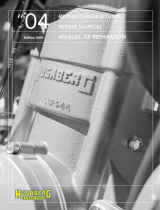
TABLE OF CONTENTS 3
11.24 Removing the air filter box lid .......................... 51
11.25 Installing the air filter box lid ........................... 51
11.26 Removing the air filter x................................ 52
11.27 Cleaning the air filter and air filter box x ......... 52
11.28 Installing the air filter x................................. 53
11.29 Securing the air filter box lid x....................... 53
11.30 Sealing the air filter box x.............................. 53
11.31 Removing the main silencer ............................. 54
11.32 Installing the main silencer.............................. 54
11.33 Changing the glass fiber yarn filling of the
main silencer x............................................. 54
11.34 Removing the fuel tank x............................... 55
11.35 Installing the fuel tank x................................ 56
11.36 Checking the chain for dirt............................... 57
11.37 Cleaning the chain .......................................... 57
11.38 Checking the chain tension .............................. 57
11.39 Adjusting the chain tension.............................. 58
11.40 Checking the chain, rear sprocket, engine
sprocket and chain guide................................. 59
11.41 Checking the frame x .................................... 60
11.42 Checking the swingarm x............................... 61
11.43 Checking the routing of the throttle cable.......... 61
11.44 Checking the rubber grip ................................. 62
11.45 Additionally securing the rubber grip................. 63
11.46 Adjusting the basic position of the clutch
lever .............................................................. 63
11.47 Checking/correcting the fluid level of the
hydraulic clutch.............................................. 63
11.48 Changing the hydraulic clutch fluid x.............. 64
12 BRAKE SYSTEM ........................................................ 66
12.1 Checking the free travel of the hand brake
lever .............................................................. 66
12.2 Adjusting the basic position of the hand brake
lever .............................................................. 66
12.3 Checking the brake discs ................................. 66
12.4 Checking the front brake fluid level .................. 67
12.5 Adding front brake fluid x.............................. 67
12.6 Checking the front brake linings ....................... 68
12.7 Changing the front brake linings x.................. 68
12.8 Checking the free travel of foot brake lever ........ 70
12.9 Adjusting the basic position of the foot brake
lever x ......................................................... 70
12.10 Checking the rear brake fluid level.................... 71
12.11 Adding brake fluid for the rear brake x............ 71
12.12 Checking the rear brake linings ........................ 72
12.13 Changing the rear brake linings x ................... 72
13 WHEELS, TIRES ........................................................ 74
13.1 Removing the front wheel x ........................... 74
13.2 Installing the front wheel x ............................ 74
13.3 Removing the rear wheel x............................. 75
13.4 Installing the rear wheel x.............................. 75
13.5 Checking the tire condition .............................. 76
13.6 Checking the tire air pressure........................... 77
13.7 Checking the spoke tension.............................. 77
14 ELECTRICAL SYSTEM ................................................ 78
14.1 Removing the battery x (250/300 XC)............. 78
14.2 Installing the battery x (250/300 XC) ............. 78
14.3 Recharging the battery x (250/300 XC)........... 78
14.4 Changing the main fuse (250/300 XC).............. 79
15 COOLING SYSTEM ..................................................... 81
15.1 Cooling system ............................................... 81
15.2 Radiator cover (All SX models) ......................... 81
15.3 Installing the radiator cover (All SX models)....... 81
15.4 Removing the radiator cover (All SX models)...... 82
15.5 Checking the antifreeze and coolant level.......... 82
15.6 Checking the coolant level ............................... 83
15.7 Draining the coolant x................................... 83
15.8 Refilling with coolant x.................................. 84
16 TUNING THE ENGINE................................................ 85
16.1 Checking the play in the throttle cable .............. 85
16.2 Adjusting the play in the throttle cable x......... 85
16.3 Carburetor - idle.............................................. 86
16.4 Carburetor - adjusting the idle speed x............ 87
16.5 Emptying the carburetor float chamber x......... 88
16.6 Plug-in connection, ignition timing map............ 88
16.7 Changing the ignition curve.............................. 89
16.8 Checking the basic position of the shift lever ..... 89
16.9 Adjusting the basic position of the shift
lever x ......................................................... 89
16.10 Engine characteristic - auxiliary spring (All
250/300 models)............................................ 89
16.11 Engine characteristic - set the auxiliary
spring x (All 250/300 models) ....................... 90
17 SERVICE WORK ON THE ENGINE ............................... 91
17.1 Checking the gear oil level ............................... 91
17.2 Changing the gear oil x.................................. 91
17.3 Draining the gear oil x................................... 92
17.4 Refilling with gear oil x.................................. 92
17.5 Adding gear oil x........................................... 93
18 CLEANING, CARE ...................................................... 95
18.1 Cleaning the motorcycle .................................. 95
19 STORAGE.................................................................. 96
19.1 Storage .......................................................... 96
19.2 Preparing for use after storage.......................... 96
20 TROUBLESHOOTING ................................................. 97
21 TECHNICAL DATA...................................................... 99
21.1 Engine ........................................................... 99
21.1.1 125 SX EU, 125 SX USA ............................ 99
21.1.2 150 SX EU, 150 SX USA ............................ 99
21.1.3 250 SX EU, 250 SX USA .......................... 100
21.1.4 150 XC USA ............................................ 100
21.1.5 250 XC EU/USA ....................................... 101
21.1.6 300 XC EU/USA ....................................... 102
21.2 Engine tightening torques .............................. 102
21.2.1 All 125/150 models.................................. 102
21.2.2 250 SX EU, 250 SX USA .......................... 103
21.2.3 250/300 XC ............................................. 104
21.3 Carburetor.................................................... 105
21.3.1 125 SX EU, 125 SX USA .......................... 105
21.3.2 Carburetor - basic setting for sandy
surfaces (125 SX EU, 125 SX USA) ........... 105
21.3.3 Carburetor tuning (125 SX EU,
125 SX USA) ........................................... 106
21.3.4 150 SX EU, 150 SX USA .......................... 107
21.3.5 Carburetor - basic setting for sandy
surfaces (150 SX EU, 150 SX USA) ........... 107
21.3.6 Carburetor tuning (150 SX EU,
150 SX USA) ........................................... 108
21.3.7 250 SX EU, 250 SX USA .......................... 109
21.3.8 Carburetor - basic setting for sandy
surfaces (250 SX EU, 250 SX USA) ........... 109
21.3.9 Carburetor tuning (250 SX EU,
250 SX USA) ........................................... 110
21.3.10 150 XC USA ............................................ 111




















